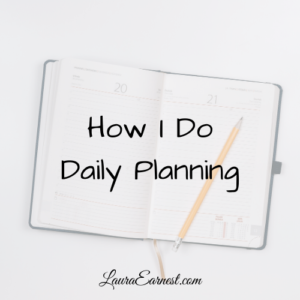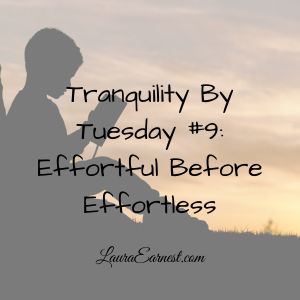Doing a weekly plan (see How I Do Weekly Planning) is a great way to frame your tasks in your schedule. But it isn’t enough, because you need to be able to figure out what you will do on any given day. Today we will look at how I do my daily planning, based on my weekly plan.
As I have shared before, I learned how to do daily planning when I purchased my first planner. It was a two page per day spread, with a time grid on one side, and a list for tasks on the other. Every day, I would fill in my schedule, then list the tasks I wanted to get done that day. If I didn’t get them done, I rewrote them onto the next day, adding new tasks. Regardless of what my schedule looked like.
Since I was a full-time engineering student at the time, working half-time in the computer lab, participating in student organizations, well, there wasn’t usually a whole lot of time. And so the tasks kept growing.
It wasn’t until some years later that I realized that the daily plan has to be rooted in reality (yeah, I know, it’s obvious). And while it’s good to have daily goals, it has to be balanced. The daily plan is focused, but it is only with the context of the week that we see beyond what is immediately in front of us. Likewise, the weekly plan isn’t worth much unless it is put into action every day (otherwise you’ll likely wait until the end of week and try to get everything done on Saturday)
Driven By the Weekly
Using the weekly plan to drive the daily means that I will have already looked at my free blocks of time, as well as the size and amount of tasks I want to do. If I want to spend three hours writing this week, I have to make sure there is room for it in the schedule. Three hours of writing can’t effectively be done in five minute increments because of cognitive switching costs.
During my weekly plan, I take a look at my schedule. This gives me some idea of the time I have available to do anything other than work, sleep and the things I’ve committed to. (Although currently under COVID-19 restrictions, my schedule is remarkably empty).
At the same time, I decide the tasks associated with my current goals are, and put those in blocks. I have a tendency to work at these tasks for amounts of time rather than trying to do something specific. This would take the form of “revise novel 30 minutes” instead of “revise chapters 3-5”. This gives me larger chunks of time to make significant progress on a task, rather than trying to snatch time from a busy evening.
My Day’s Schedule
With this weekly framework in hand, I plan my day. I’m currently using the Bullet Journal method (https://bulletjournal.com/). So the night before, I will set up my header, which includes the date, the day of week, and brief weather information.
Then I list out my daily time commitments. This includes work, commuting time, and any other meetings I might have.
My Tasks
Next I look at my task list (Remember The Milk) and see what I have on for the next day. I list these out, being conscious of the amount of free time I have in the day. I sometimes will push tasks off if I have a very busy day. If I don’t have enough to do (hah! like that happens!) I will look at tasks for the rest of the week and add them to the day.
The goal here is to give myself enough tasks to do to keep me moving forward as well as keep me from having to exhaust myself on the weekend trying to catch up. This means I have to have a good feel for how long each task will take, as well as a sense of how my energy will be. I can’t schedule a three hour gardening session after I have spent a whole day at work.
Rough Timeblocking
At the top of the day, as a sort of divider, I put in a time bar. (You can see pictures of this at My Bullet Journal Setup) This is a horizontal listing of all the hours that I then color in so I can have a visual representation of my hours.
Once everything that is on the weekly schedule is filled in, I can see my free time. I can then group tasks together based on location or equipment and roughly block them. This serves two purposes. The first is that it makes me think about how to get the tasks done. The second is that it gives me another way to check that I’m not overloading my time and energy.
Conclusion
By running my daily plan off of my weekly, I have a framework in which to decide which tasks I will tackle. This keeps me from overloading, as well as gives me room to make progress on bigger projects.







